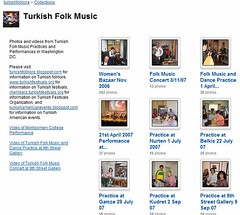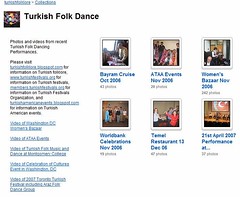By S.A. Clements (published in Hyattsville Life&Times, May 2007)
Hyattsville is known for, among other things, its diversity of population. This was demonstrated again recently by a performance put on by Osman Karaarslan of Kennedy Street in Hyattsville and his fellow members of the Turkish Folk Music Group. The venue was Globe Hall on the Germantown campus of Montgomery College.
The Turkish Folk Music Group opened the program with a selection of hauntingly beautiful folk songs played by six men playing the baglama, and one playing an unusual type of drum.
They were followed by a talented group of the Washington, D.C. Turkish Folk Dance Troupe, who performed a series of traditional folk dances, such as you would see at country weddings or other family gatherings.
We are indebted to the above two groups for the following descriptions of the instruments and of the music and dance.
Turkish Folk Instruments
Folk instruments range from string groups as baglama; bow instruments such as the kemenche, a type of stave fiddle; and percussion and wind, including the zurna, ney and davul. Regional variations place importance on different instruments, e.g. the darbuka in Rumeli and the kemenche around Black Sea region.
The folklore of Turkey is extremely diverse. Nevertheless, Turkish folk music is dominantly marked by a single musical instrument called saz or baglama, a type of long-necked lute. Traditionally, saz is played solely by traveling musicians known as ozan or religious Alevi troubadours called asik.
Due to cultural crossbreeding prevalent during the Ottoman empire, the baglama has influenced various cultures in the Eastern Mediterranean. In Turkish, baglamak means 'to tie' as a reference to the strings of the instrument. Like most stringed instruments, it can either be played with a plectrum (i.e., pick), or with a finger picking style. The zurna and davul duo is also popular in rural areas, and are played at weddings and other local celebrations.
Turkish music and dance
Folk music or Tlirkii generally deals with subjects surrounding daily life in less grandiose terms than the love and emotion usually contained in its traditional court music of the Ottoman Empire. Most songs recount stories of real life events or have developed through song contests between troubadour poets. Corresponding to their origins, folk songs are usually played at weddings, funerals and special festivals.
Regional folk music generally accompanies folk dances, which vary significantly accross regions. For example, at marriage ceremonies in the Aegean, guests will dance the Zeybek, while in other Rumeli regions the upbeat dance music Ciftetelli is usually played and in the southeastern regions of Turkey the Halay is the customery form of local wedding music and dance.
The regional mood also affects the subject of the folk songs, e.g. folk songs from the Black Sea are lively in general and express the customs of the region. Songs about betrayal have an air of defiance about them instead of sadness, whereas the further south traveled in Turkey the more the melodies resemble a lament.
Photos
Video
Followers
Turkish Folk Music and Dance Groups in the USA and Canada
Turkish Folklore Blog can help promote your group on this site and on its affiliated web sites. Interested groups should submit a post describing their group. Requests should be submitted to support@turkishfestivals.org.
Tuesday, September 18, 2007
Saturday, September 15, 2007
Welcome to Turkish Folklore Blog
Welcome to Turkish Folklore blog. Prospective authors are encouraged to first submit a brief summary of their post by emailing here. Posts and comments to posts must be submitted in English language. Site administrators have full authority to accept or reject any posts, remove any post, or comment(s) to any posts from the site at any time and for any reason. Please report any concerns about posts and comment(s) to posts to the site administrator.
Subscribe to:
Posts (Atom)

